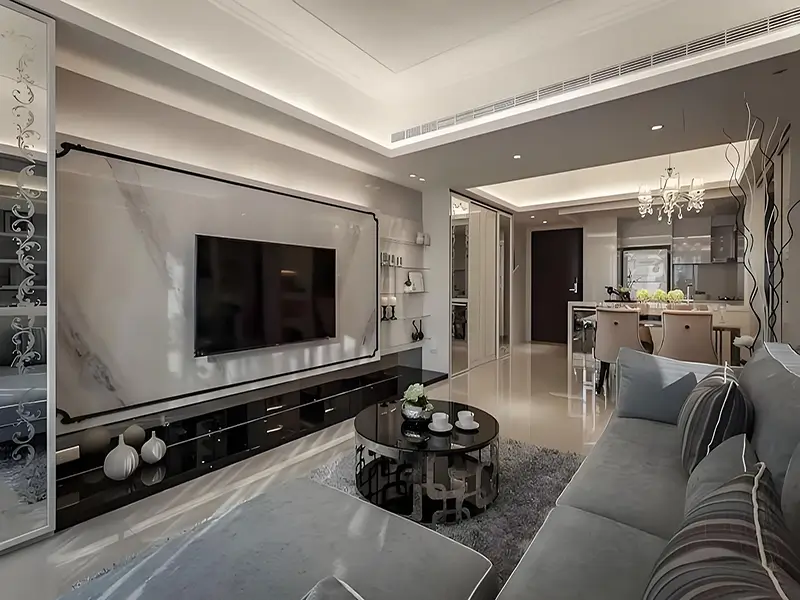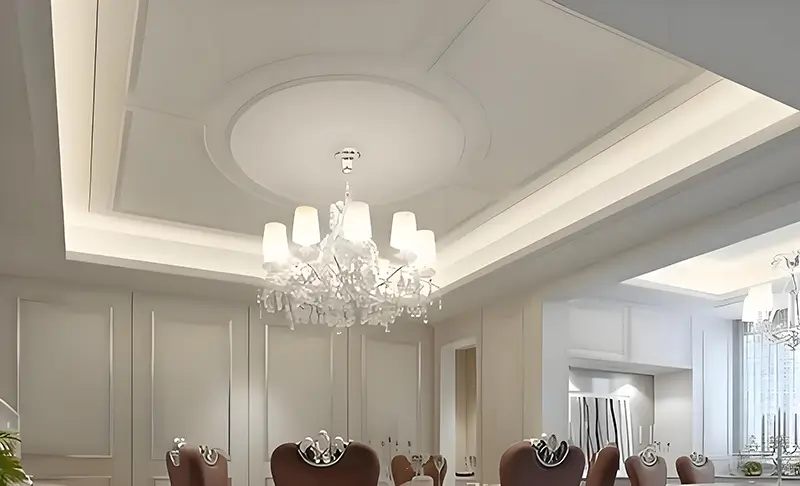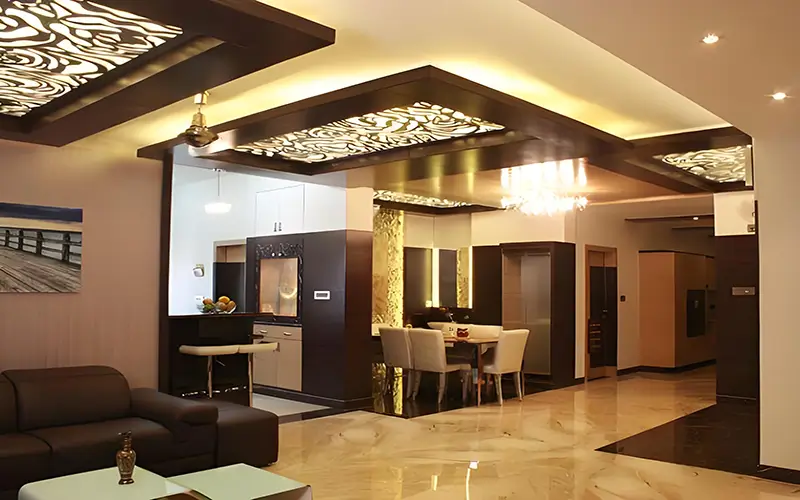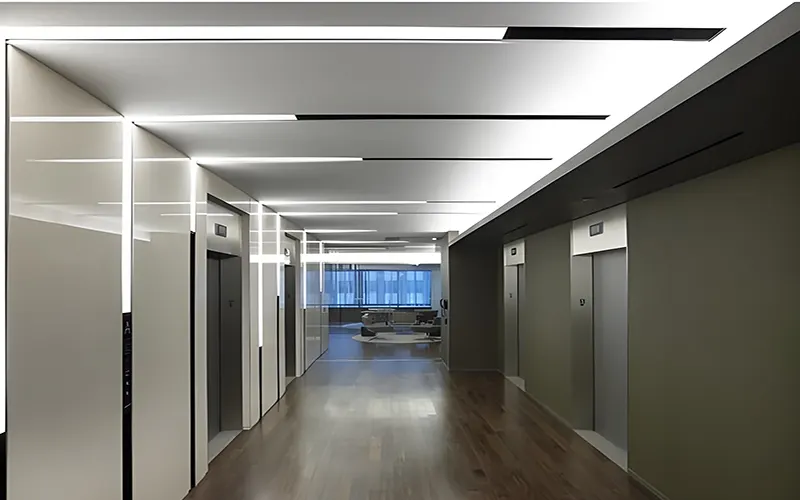
False Ceiling Profile Light, also known as suspended ceilings, offer a functional and aesthetic solution for a variety of spaces. They can conceal building elements like pipes and wires, improve acoustics, and provide thermal insulation. But when it comes to lighting, false ceilings can unlock a whole new world of design possibilities with the help of profile lights.
What are False Ceiling Profile Lights?
False ceiling profile lights, also known as LED light channels, LED profile lights, or LED light extrusions, are a type of lighting system that integrates seamlessly into the design of your false ceiling. These profiles are typically made of aluminum and house LED strips, creating a sleek and modern look.
Profile lights offer a significant advantage over traditional lighting options like recessed cans. They provide diffused, even illumination without the bulky and often visually unappealing fixtures. Additionally, profile lights come in a wide variety of shapes, sizes, and finishes, allowing for a high degree of customization to suit any design style.

Types of Profile Light Design in Ceiling
When it comes to incorporating profile lights into your false ceiling design, you have a multitude of options to explore. Here are some popular types of profile light designs:
Recessed Profile Lights
This is a classic and versatile option where the profile is installed flush with the ceiling surface. Recessed profile lights offer a clean and minimalist look, ideal for contemporary spaces.
Surface-Mounted Profile Lights
As the name suggests, surface-mounted profile lights are installed directly onto the surface of the false ceiling. This option creates a more layered effect and can be used to add visual interest to a plain ceiling.
Corner Profile Lights
Corner profile lights are designed to be installed at the junction between the wall and the ceiling. They create a soft, ambient glow that can add depth and dimension to a space.
Cove Lighting
Cove lighting is achieved by installing profile lights behind a strategically placed overhang or soffit in the ceiling. This technique creates a subtle and elegant lighting effect, perfect for highlighting architectural features or artwork.
Indirect Lighting
Indirect lighting involves directing the light from the profile upwards towards the ceiling. This creates a diffused and spacious feel, ideal for creating a relaxing atmosphere.
Profile Light Ceiling Design Ideas
With the different types of profile lights at your disposal, you can achieve a variety of design effects. Here are some inspiring ideas to get you started:
Geometric Patterns: Use a combination of straight and angled profile lights to create geometric patterns on your ceiling. This approach can add a touch of dynamism and modernity to any space.
Task Lighting: Profile lights can be strategically placed to define different zones within a room. For example, you can use brighter light profiles in work areas and softer light profiles in relaxation areas.
Highlighting Architectural: Draw attention to architectural elements like beams or columns by installing profile lights behind them. This creates a sophisticated and visually interesting effect.
Curved Lines: For a more organic feel, incorporate curved profile lights into your design. This can help soften the lines of a room and create a more inviting atmosphere.
Starlight Ceiling: Recreate a magical night sky effect by installing tiny pinhole LED profile lights throughout the ceiling. This is a great option for children’s bedrooms or home theaters.
Choosing the Right Ceiling Profile Light
With the vast array of profile light designs available, choosing the right one for your project can seem daunting. Here are some key factors to consider:

Size and layout: The size of the profile light should be proportionate to the size of the room. For larger spaces, you may opt for wider profiles or multiple profiles installed in parallel.
Desired lighting effect: Consider the type of atmosphere you want to create. Recessed lights offer a more subtle effect, while surface-mounted lights can make a bolder statement.
Functionality of the space: If you need task lighting in specific areas, consider using profile lights with adjustable beams or diffusers.
Overall design style: Choose a profile light finish and design that complements the overall aesthetic of your space.
Pay attention to the Details When Using a False Ceiling Profile Light
False ceiling profile light are a stylish and versatile way to elevate your space. However, to ensure a truly harmonious integration, it’s important to avoid some common mistakes. Here are some things to look out for:
Size of your space
Scale is important! Oversized outline lights can make a small room look crowded, while small fixtures can get lost in a large space. Choose outline lights that are proportional to the room dimensions and ceiling height. This ensures they enhance the overall aesthetic rather than creating an unbalanced look.
Design harmony
Maintain a coherent design theme throughout the space to avoid visual dissonance. Consider an existing design theme and choose an outline that resonates with it. Mismatches can create visual dissonance and make the space feel cluttered.
The art of dimming
Outline lights shouldn’t be a one-trick pony. Incorporating dimming controls allows for the flexibility to create different atmospheres, from bright and vibrant for work areas, to soft and relaxing for living spaces. Without them, you won’t be able to adjust the atmosphere as needed.
Energy-saving
Choose LED outline lights for sustainable development and reduced energy bills. LEDs are more energy efficient than traditional lighting, reducing environmental impact and long-term costs.
Wiring and Installation Planning
A well-planned installation is the foundation for a sophisticated look. Visible wires disrupt visual flow, while faulty installations can lead to future maintenance headaches. Carefully plan the wiring layout to ensure seamless integration, and entrust the installation to skilled professionals.
By taking these steps, you can avoid common problems and turn your profile lights into a beautiful, functional element in your space.
Summarize
This article explores the world of false ceiling profile light, a lighting solution that blends seamlessly into suspended ceiling designs. We take an in-depth look at the different types of LED aluminum profiles.
By following these guidelines, you can create a cohesive and stunning look with false ceiling contour lights.
FAQs
False ceiling profile lights offer several benefits over traditional lighting options. They provide diffused, even illumination without bulky fixtures and come in a variety of styles to suit any design. Additionally, they are energy-efficient and can be dimmed for added versatility.
Consider several factors when choosing false ceiling profile lights, such as the size of the room, the desired lighting effect, and the overall design style. You should also think about the functionality of the space and whether you need dimming capabilities.
Some profile light systems are designed for DIY installation, but complex designs or those requiring electrical expertise are best left to professionals. It’s important to ensure proper wiring and placement for a safe and aesthetically pleasing outcome.
Answer: The cost of false ceiling profile lights can vary depending on the size, style, and features. Typically, they are priced per meter or length.
While some profile lights may be water-resistant, they are generally not designed for outdoor use. Exposure to rain, snow, and extreme temperatures can damage the electrical components. It’s best to choose outdoor-rated lighting fixtures for exterior applications.




